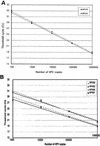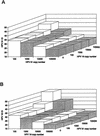Real-time PCR-based system for simultaneous quantification of human papillomavirus types associated with high risk of cervical cancer
- PMID: 12843067
- PMCID: PMC165384
- DOI: 10.1128/JCM.41.7.3221-3228.2003
Real-time PCR-based system for simultaneous quantification of human papillomavirus types associated with high risk of cervical cancer
Abstract
We have previously shown that women with a high titer of human papillomavirus type 16 (HPV16) in cervical epithelial cells have an increased risk of developing cervical carcinoma in situ. In order to study the relationship between viral DNA amount and risk of cervical carcinoma for the HPV types most commonly found in cervical tumors, we developed a real-time PCR assay for the detection and quantification of HPV16, -18, -31, -33, -35, -39, -45, -52, -58, and -67. These HPV types are analyzed in two reaction tubes, allowing for independent quantification of three viral types, or groups of viral types, in each reaction. A separate reaction is used for estimating the number of a nuclear single-copy gene and is used to calculate the HPV copy number per genomic DNA equivalent in the sample. The system has a dynamic range from 10(2) to 10(7) HPV copies per assay and is applicable to both fresh clinical samples and DNA extracted from archival samples. Reconstitution experiments, made to mimic infections with several HPV types, shows that individual HPV types can be detected in a mixture as long as they represent 1 to 10% of the main type. The system was evaluated with respect to technical specificity and sensitivity, reproducibility, reagent stability, and sample preparation protocol and then used to analyze clinical samples. This homogeneous assay provides a fast and sensitive way for estimating the viral load of a series of the most frequent oncogenic HPV types in biopsies, as well as cervical smear samples.
Figures






Similar articles
-
Human papillomavirus (HPV) DNA copy number is dependent on grade of cervical disease and HPV type.J Clin Microbiol. 1999 Apr;37(4):1030-4. doi: 10.1128/JCM.37.4.1030-1034.1999. J Clin Microbiol. 1999. PMID: 10074522 Free PMC article.
-
Evaluation of high-risk human papillomavirus types PCR detection in paired urine and cervical samples of women with abnormal cytology.J Clin Virol. 2006 Jul;36(3):189-93. doi: 10.1016/j.jcv.2006.03.009. Epub 2006 May 11. J Clin Virol. 2006. PMID: 16690350
-
[Detection and typing of human papilloma virus by polymerase chain reaction and hybridization assay in cervical samples with cytological abnormalities].Mikrobiyol Bul. 2008 Apr;42(2):273-82. Mikrobiyol Bul. 2008. PMID: 18697425 Turkish.
-
Comparison of the Digene HC2 assay and the Roche AMPLICOR human papillomavirus (HPV) test for detection of high-risk HPV genotypes in cervical samples.J Clin Microbiol. 2006 Jun;44(6):2141-6. doi: 10.1128/JCM.00049-06. J Clin Microbiol. 2006. PMID: 16757611 Free PMC article.
-
Performance assessment of eight high-throughput PCR assays for viral load quantitation of oncogenic HPV types.J Mol Diagn. 2004 May;6(2):115-24. doi: 10.1016/S1525-1578(10)60499-0. J Mol Diagn. 2004. PMID: 15096567 Free PMC article.
Cited by
-
Type distribution, viral load and integration status of high-risk human papillomaviruses in pre-stages of cervical cancer (CIN).Br J Cancer. 2005 Jun 20;92(12):2195-200. doi: 10.1038/sj.bjc.6602648. Br J Cancer. 2005. PMID: 15942630 Free PMC article.
-
Accuracy of real-time PCR assays for human papillomavirus using urine samples: a systematic review and meta-analysis.J Clin Microbiol. 2025 May 14;63(5):e0135224. doi: 10.1128/jcm.01352-24. Epub 2025 Mar 31. J Clin Microbiol. 2025. PMID: 40162806 Free PMC article.
-
Clinical validation of the HPVIR high-risk HPV test on cervical samples according to the international guidelines for human papillomavirus DNA test requirements for cervical cancer screening.Virol J. 2019 Aug 22;16(1):107. doi: 10.1186/s12985-019-1216-7. Virol J. 2019. PMID: 31438976 Free PMC article.
-
Results of cytology and high-risk human papillomavirus testing in females with cervical adenocarcinoma in situ.Oncol Lett. 2013 Jul;6(1):215-219. doi: 10.3892/ol.2013.1350. Epub 2013 May 15. Oncol Lett. 2013. PMID: 23946807 Free PMC article.
-
An inter-platform repeatability study investigating real-time amplification of plasmid DNA.BMC Biotechnol. 2005 May 25;5:15. doi: 10.1186/1472-6750-5-15. BMC Biotechnol. 2005. PMID: 15916714 Free PMC article.
References
-
- Bosch, F. X., M. M. Manos, N. Munoz, M. Sherman, A. M. Jansen, J. Peto, M. H. Schiffman, V. Moreno, R. Kurman, K. V. Shah, et al. 1995. Prevalence of human papillomavirus in cervical cancer: a worldwide perspective. J. Natl. Cancer Inst. 87:796-802. - PubMed
-
- Chua, K. L., and A. Hjerpe. 1995. Polymerase chain reaction analysis of human papillomavirus in archival cervical cytologic smears. Anal. Quant. Cytol. Histol. 17:221-229. - PubMed
-
- Higuchi, R., C. Fockler, G. Dollinger, and R. Watson. 1993. Kinetic PCR analysis: real-time monitoring of DNA amplification reactions. Bio/Technology 11:1026-1030. - PubMed
Publication types
MeSH terms
Substances
LinkOut - more resources
Full Text Sources
Other Literature Sources
Medical

